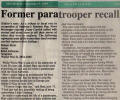|
 Robert
Hart, a former paratrooper who jumped as part of the 82nd Airborned
[sic] Division on the eve of D-Day, holds patches which, he says, were
the only markings allowed [to be] worn on his uniform during missions. Robert
Hart, a former paratrooper who jumped as part of the 82nd Airborned
[sic] Division on the eve of D-Day, holds patches which, he says, were
the only markings allowed [to be] worn on his uniform during missions.
[published in News Messenger, Lincoln, CA, 9 November
1995] |
 |
Former Paratrooper Recall
Editor's note: As
tribute to local vets in recognition of Saturday's Veterans Day, News
Messenger reporter Jenny Carrick talked with several and asked the to
tell their stories of when they were in uniform. The following
represent some of the events these local veterans say best captures
their feelings.
Robert Hart
Army
82nd Airborne
Sergeant
World War II
While World War Ii and all of his
memories are 50 years old, Robert Hart van recall most everything he saw
and did wile a paratrooper with the 82nd Airborne.
Hart's career began as an instructor for boot camp in Missouri.
But his desire to join the troops overseas landed him in Europe just
before D-Day in 1944.
"I'll never forget that day," said Hart, now 75, "I had just had
this incredible feeling of being somewhere I didn't belong."
In order to understand the life of a paratrooper, Hart said a full
description of their uniform and gear |
was necessary.
The men wore little insignia with the exception of an Allied
Airborne patch on the sleeve of a drab paratrooper jump suit.
Their parachute packs were harnessed to their chests. Each
pack contained two parachutes, a 28-foot chute and a 22-foot secondary
chute as a back up.
In addition, the troopers carried grenades, machine guns,
rifles, knives and ammunition.
"The amount of weight we carried was enormous," Hart said. "When we
got on those planes it felt like a ton."
One reason why paratroopers during World War II were forced to
carry so much weaponry was that once they dropped behind enemy lines,
they were left essentially on their own. Most units were unable to call
for assistance or much backup,
As the planes swarmed above the coast of France to drop the troops
into Normandy, Hart said the dark interiors of the planes were lit up
with tracers, flaming bullets, from enemy fire."
Suddenly things seemed to go wrong and Hart knew he plane had
passed the target.
With an engine on fire and the plane swooping |





